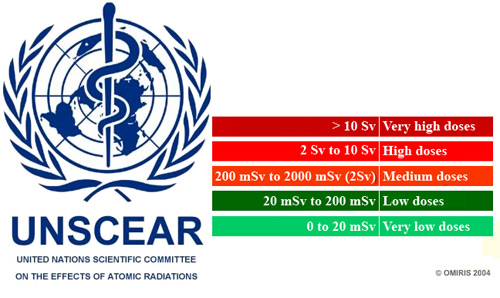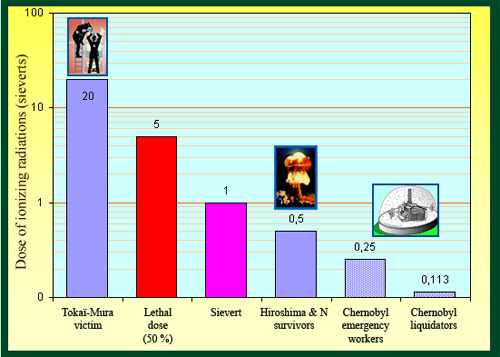A dose classification for acute exposures
When dealing with exposure to radiations, what do we mean by strong or weak doses? Even among experts the question has led to much debate. For some, all exposure is dangerous: the smallest dose is already too strong. For others, the effects of radioactivity must not be overestimated. Levels of exposure in Western Europe as a consequence of the Chernobyl accident have all been correspondingly ‘weak’ – but this is not the perception among members of the public.
The United Nations scientific committee on the effects of atomic radiations (or UNSCEAR) has established a way of classifying exposure levels based on the thresholds above which deterministic effects occur, in other words effects which are felt by all individuals exposed above these thresholds. The UNSCEAR classification applies only to effective doses corresponding to acute global exposures, which means a dose received by the whole body during one short and intense irradiation. Deterministic effects can also appear with short doses administered to specific parts of the body: such as the testicles (transitory or permanent sterility), the ovaries (permanent sterility), the eyes (cataract) or the skin (erythema, necrosis).

Classification of doses (acute exposures)
This classification of effective doses from the UNSCEAR (United Nations Scientific Committee on the Effects of Atomic Radiation) refers doses due to acute global exposures, ie doses received in one burst by the whole body during a short period of time. The resulting effects are known as deterministic (apparition of post-irradiation short-term biological symptoms) by opposition to stochastic effects such the appearance with a low probability of eventual cancers or hereditary mutations many years after.
© OMIRIS
One should distinguish between intense, short-lived exposures and the chronic and long-term exposures such as for instance the exposure to natural radioactivity. It is the deterministic effects caused by the first types that need to be considered in priority, since severe exposures to high levels of radiation can be life-threatening. This is why the UNSCEAR’s classification deals mainly with this type of exposure.
Effective doses below 200 millisieverts (mSv) are considered to be low or weak, and below 20 mSv they are said to be very low or very weak. Radiation absorbed in a medical context (excluding radiotherapy) as well as those occurring fronm natural sources fall into this category. Doses in this range are characterised by a lack of deterministic effects – i.e. short-term biological signs or post-radiation symptoms.
Such deterministic effects appear for acute effective doses classified as medium, strong and very strong by the UNSCEAR. Absorption of a dose between 0.5 and 2 sieverts (Sv) will result in a light reaction involving nausea, asthenia and vomiting between 3 and 6 hours after the exposure. Somewhere between 4 and 4.5 Sv lies the so-called DL50 level, which is the point at which exposure will be fatal in 50% of cases. Patients whose entire bodies have been exposed to doses of this magnitude will exhibit Acute Radiation Syndrome (ARS), a condition whose severity will depend on the dose absorbed, the exposure time, the type of radiation involved and the distribution of the radiation through the body. ARS is characterised by hematological symptoms (bone marrow damages), digestive symptoms (gastro-intestinal tract damages) and neurological symptoms in the central nervous system.

Examples of strong doses
The sievert, as a dose unit, represents a strong exposure as can be seen from this sample of exposures considered to be high. The highest dose represented here – 20 Sv – is that suffered by one of the two workers of Tokaimura who died after receiving 4 times the lethal dose. Survivors of Hiroshima were exposed to varying doses, ranging from a few millisieverts (mSv) to 500 mSv. On average, the Chernobyl liquidators received around 100 mSv. The group of more exposed firefighters received 250 mSv on average, 163 of them exceeding 1 Sv.
© IN2P3
Deterministic effects must be distinguished from the long-term stochastic (or probabilistic) effects, which are characterised by an increased risk of cancer and genetic mutations. These stochastic effects are present in the weak dose region as well as the strong dose region, and the assumption has been made that all exposures (no matter the size of the dose) carry with them a risk of stochastic effects. The probability of a cancer being set off is of around 5% per sievert. These probabilities become negligible at doses of a fraction of a sievert.
The french regulation place an upper limit of 1 mSv on exposure for the general public, excluding all natural and medical sources of radiation. This value corresponds to a dose more than very low in the dose scale of deterministic effects.
By comparison, the UNSEAR classification of a 1 Sv (1000 mSv) dose as ‘medium-strength’ may come as a surprise. However, while this value does correspond to a high dose when compared to the limit set to minimise the risk of stochastic effects (cancers, mutations) in the population, it actually appears medium in the field of acute irradiations with their deterministic symptoms,
NEXT : MilliSievert unit
Other articles on the subject « Radioactive Doses »
Radioactive Activity Doses
Becquerel or Bq : the activity unit of a radioactive source The activity of a sample of matter wh[...]
Absorbed doses
Gray or Gy : unit of energy deposited in matter by radiation The ‘absorbed dose’ is defined as th[...]
Biological doses
Sievert (Sv) : the unit of doses for the living The energy deposited in a living organism by radi[...]
Equivalent Dose
A local biological dose The concept of the « equivalent dose » which takes into account the natur[...]
Effective Dose
A full-body dose, central in the field of radioprotection The « effective dose » is a biological [...]
MilliSievert
A unit for low doses of radioactivity After a nuclear accident or accident of radioactivity, it i[...]